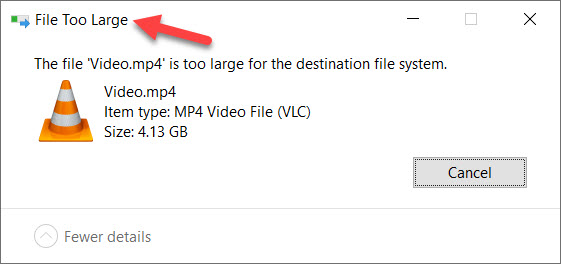Many users of Windows, especially beginners, are often confused when they see the following error while copying large files to a USB or portable drive in Windows:
"The file is too large for the destination file system."
At first glance, it might seem like the drive doesn’t have enough space. But that’s not the real issue. Even if your flash drive has plenty of free space, this error can still appear. The actual problem lies in the file system type used by the destination drive.
Let’s break this down in a simple and technical way.
Why am I seeing this error?
When Windows says that a file is too large for the destination file system, it doesn’t mean you’ve run out of space. It means the file you are copying is too big for the type of file system your drive is using.
Flash drives and memory cards are typically formatted using the FAT32 file system. The FAT32 file system has a major limitation:
FAT32 does not support individual files larger than 4 GB.
What is a File System?
The file system is a method an operating system uses to store, organize, and retrieve files and data on a storage device. A file system is essentially an intermediary between the operating system and the storage device. All storage device has specific file system types to store and manage data. Think of it as the way the drive organizes files internally.
Understanding File Systems: FAT32, NTFS, and exFAT
Windows primarily supports three widely used file systems: FAT32, exFAT, and NTFS.
FAT32 (File Allocation Table 32)
FAT (File Allocation Table) is a file system that was first introduced in Windows 95 by Microsoft in 1995. FAT32 is widely used on computer systems, memory cards, and Flash/Pen Drives. FAT32 is a file system architecture that is not as efficient as NTFS but offers greater compatibility with other operating systems.
- ✅ Great for compatibility
- ❌ Cannot store files larger than 4 GB
- ❌ Max partition size: 32 GB (in Windows)
NTFS (New Technology File System)
NTFS (New Technology File System) is a file system that was first introduced in Windows NT by Microsoft in 1993. Later, it started using Windows XP and followed to use it on all subsequent versions of Windows as the default file system. The NTFS file system has several improvements over FAT32. Moreover, this file system does not have file partition and file size limitations.
It is the default File System for all modern Windows Operating Systems (since Windows XP)
- ✅ Supports large file sizes (up to 16 TB+)
- ✅ More secure and reliable
- ❌ Limited compatibility with macOS/Linux without special drivers
exFAT (Extended FAT)
It was designed to bridge FAT32’s limitations
- ✅ Supports large files and large partitions
- ✅ Better cross-platform support than NTFS
- Ideal for USB drives shared between Windows and macOS
How to Fix the Issue?
There are two main solutions:
Option 1: Convert FAT32 to NTFS (Without losing data)
You can convert your FAT32 drive to NTFS using the Command Prompt—without formatting or losing any files.
Steps:
1: Open Command Prompt as Administrator.
2: Type below command:
bash
convert X: /fs:ntfsHere, X is the drive that you want to convert. Replace X: with your drive letter.
4: Press Enter and wait for the conversion to complete
Option 2: Format the Drive to NTFS (Data Will Be Erased)
If you don’t mind erasing the drive contents, formatting is quicker.
Steps:
1: Go to File Explorer (Windows Key + E), Right-click on the drive.
2: Select the Format option.
3: In the File System drop-down, choose NTFS and click on the Start button.
This method will delete all the files on the drive and will change the File System to NTFS.



If you format your pen drive with FAT format I think you can copy FAT file of any size to your pen drive.
My friends are calling me techie after reading your article..haaaa
Thankyou for the wonderful article.
i have learnt a lot from here..
I am trying to dual boot Ubuntu and Mac OS X on a 3rd edition Macbook Pro and I am running into problems?
Just cause it’s smilpe doesn’t mean it’s not super helpful.
You can use Boot Camp Assistant on mac and then install ubuntu.
its located in "/Applications/Utilities/" and follow the instruction.
Hi THIS IS COMMON PROBLEM WITH WIN XP AND WIN VISTA when transfering or copying files esp above 2 or 4 GB . I've simple solution attach pen drive or memory card to ur usb port open Windows Explorer/My Computer ..now right click on the drive letter SELECT OPEN AS "PORTABLE MEDIA DEVICE"..THIS OPENS NEW WINDOW..DRAG AND DROP OR COPY PASTE THE HUGE FILES INTO THIS WINDOW. NO NEED TO FORMAT OR CHANGE PARTITION TYPE!! NOTE THIS IS SLOW AS NOW COPMPUTER WILL TREAT AS PORTABLE DEVICE INSTEAD OF USB Kunal Waghmare kw20@indiatimes.com
There are no words to dsericbe how bodacious this is.
You do not know how many times I have struggled with this. Thanks so much for explaining.